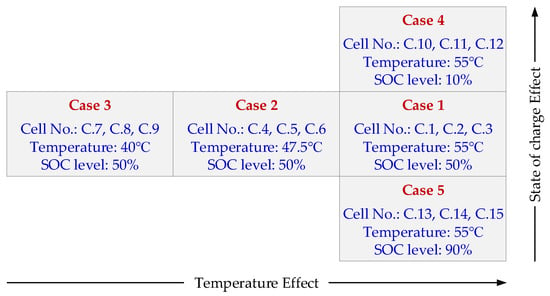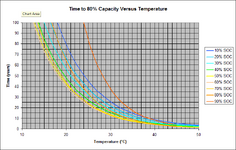jtr1962
Flashaholic
I recently came across this study on LiFePO4 aging:

 www.mdpi.com
www.mdpi.com
This is a subject I have interest in because in most of my use cases it will take me many decades to reach cycle life. That's especially true in the case of LFP batteries which are good for many thousands of cycles.
I decided to make a spreadsheet using the equations in the study to produce two charts.
The first chart is capacity versus time at various temperatures and a 50% SOC (state-of-charge):

The second is the time to 80% at various SOCs and temperatures:

Some general observations:
1) Lower temperatures slow aging dramatically.
2) Cell aging is slowest at very low and very high states of charge.
3) Aging rates at a given state-of-charge and temperature appear to be linear with time.
In the real world cells self discharge. Therefore, if they're just sitting unconnected to power any results with high SOC are meaningless. The cell will eventually self discharge to well under 80% SOC in a few years or less. For these reasons I prefer to use the 40% or 50% SOC results. Recommendations for long-term storage are generally in that area anyway. If the battery is being cycled, then the average SOC will probably be in the 50% SOC area, so this rule of thumb works for cells which are in use also.
At normal room temperatures and 50% SOC these cells last for decades before they degrade to 80% capacity. You get over 20 years at 25°C (77°F), and over 40 years at 20°C (68°F). In a cool basement which averages 15°C the cells could last a lifetime if they're lightly cycled.
Bottom line is I'm very pleasantly surprised how long LFP cells last.
I attached a .zip file containing the spreadsheet if anyone wants to play around with it.

The Degradation Behavior of LiFePO4/C Batteries during Long-Term Calendar Aging
With widespread applications for lithium-ion batteries in energy storage systems, the performance degradation of the battery attracts more and more attention. Understanding the battery’s long-term aging characteristics is essential for the extension of the service lifetime of the battery and the...
This is a subject I have interest in because in most of my use cases it will take me many decades to reach cycle life. That's especially true in the case of LFP batteries which are good for many thousands of cycles.
I decided to make a spreadsheet using the equations in the study to produce two charts.
The first chart is capacity versus time at various temperatures and a 50% SOC (state-of-charge):
The second is the time to 80% at various SOCs and temperatures:
Some general observations:
1) Lower temperatures slow aging dramatically.
2) Cell aging is slowest at very low and very high states of charge.
3) Aging rates at a given state-of-charge and temperature appear to be linear with time.
In the real world cells self discharge. Therefore, if they're just sitting unconnected to power any results with high SOC are meaningless. The cell will eventually self discharge to well under 80% SOC in a few years or less. For these reasons I prefer to use the 40% or 50% SOC results. Recommendations for long-term storage are generally in that area anyway. If the battery is being cycled, then the average SOC will probably be in the 50% SOC area, so this rule of thumb works for cells which are in use also.
At normal room temperatures and 50% SOC these cells last for decades before they degrade to 80% capacity. You get over 20 years at 25°C (77°F), and over 40 years at 20°C (68°F). In a cool basement which averages 15°C the cells could last a lifetime if they're lightly cycled.
Bottom line is I'm very pleasantly surprised how long LFP cells last.
I attached a .zip file containing the spreadsheet if anyone wants to play around with it.


